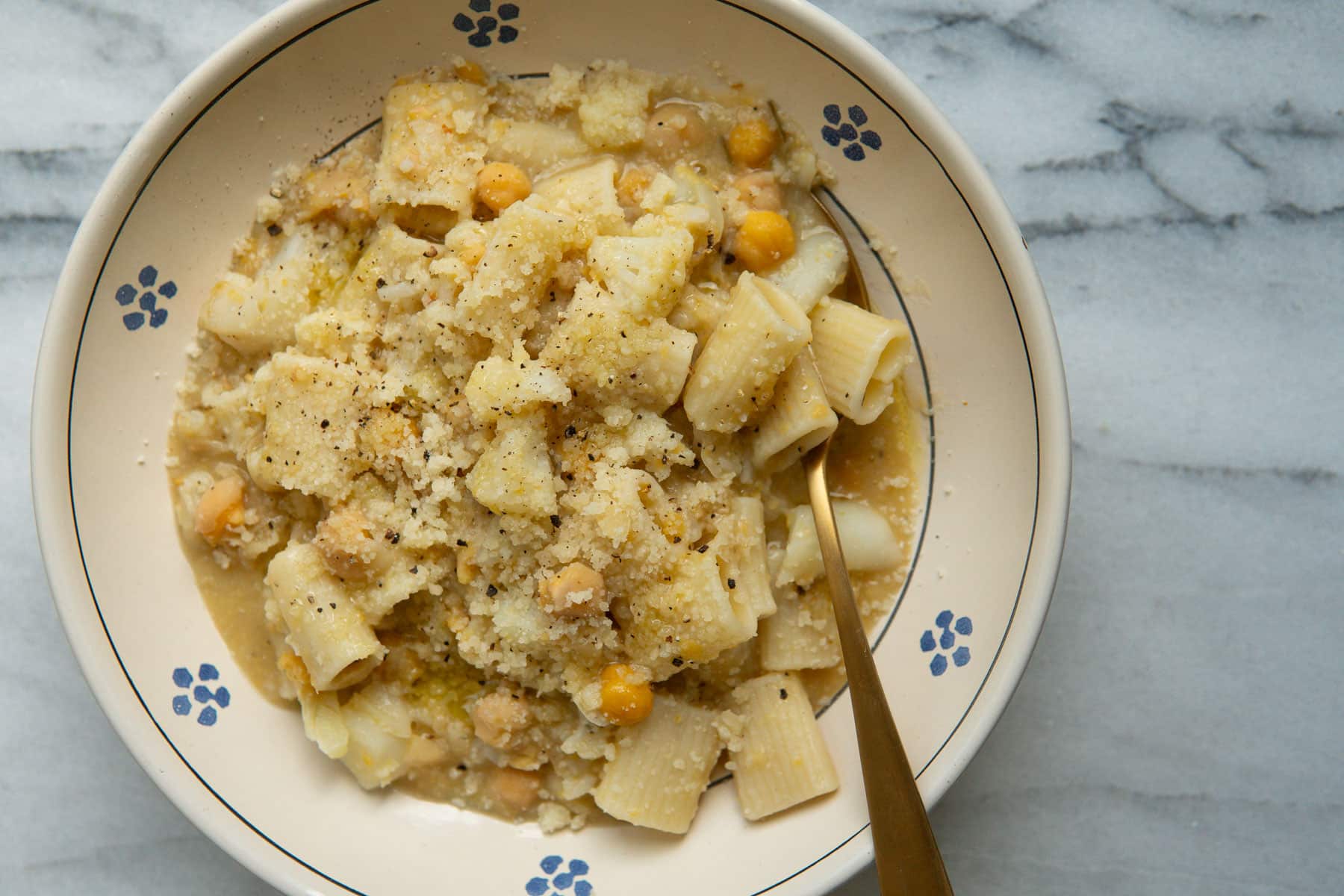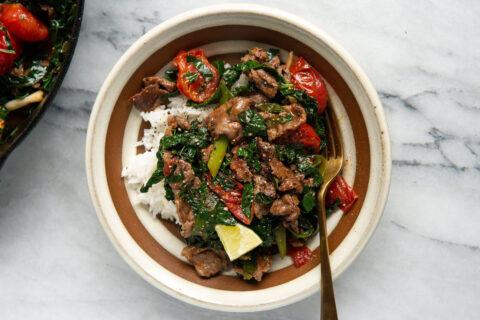
This pasta was inspired by a trip to the Puglia region of Italy which is known for its “cucina povera” dishes (“the kitchen of poor”), which takes inexpensive ingredients and turns them into hearty, nourishing dishes. Since meat was very expensive, the cuisine leans vegetarian and uses legumes in most of their staple dishes.
We took a pasta making class with a local and made a classic Puglian pasta “ciceri e tria”, which means pasta and chickpeas. The traditional dish also adds fried pasta to make it extra hearty and add more texture, but we’re skipping that part to keep it easy.
Pasta, chickpeas, and cauliflower get cooked in one pot with garlic and rosemary until a saucy, starchy pasta sauce forms. Mashing the chickpeas a bit helps thicken the sauce and the cauliflower becomes so soft that it melts into the dish. I hope you love this as much as I do!
Ingredient higlight
Chickpeas! Like many other legumes are rich in protein, fiber, folate, zinc, calcium, magnesium and iron. They also contain vitamin K which, along with calcium, is a key nutrient for strong bones. Chickpeas are uniquely rich in certain flavonoids (mostly in the outer part of the chickpea) and antioxidants that will help fight off inflammation and free radicals.




From our cooking class with Paola in Lecce, Italy!





Ingredients
- 3 tbsp olive oil
- 4 cups finely chopped cauliflower (chopped small, from ~ 1.5 lb head)
- 2 (15 oz) cans chickpeas, drained and rinsed
- 3 cloves garlic, smashed or thinly sliced
- 2 tsp kosher salt, divided
- ½ tsp black pepper
- ¼ tsp red pepper flakes (optional)
- 6 cups water
- 8-10 oz pasta*
- 1 tsp dried rosemary or 2 sprigs fresh rosemary
- Parmesan cheese, for topping
- Lemon wedges
- *You can use whatever pasta shape you have. I tested using a short tubular pasta shape rather than a longer noodle shape. All pasta cooks at different rates, so use your judgment for doneness. It’s fine if the pasta is a little more or less brothy.
- *I tested both 8 and 10 oz. Using 8 oz will result in a more liquidy broth with less pasta, whereas 10 oz will be a bit more pasta with a bit less liquid. Both are delicious!
- Fun fact! ~ In Italy garlic is usually smashed and added whole into the oil and then removed after it has infused the oil. This is because they feel it can be overpowering. Our cooking class instructor told us that it’s also removed so you don’t give dinner guests bad breath. So leave it in or do as the Italians do and remove it before adding the liquid!
Instructions
- In a large pot over medium heat, warm the oil. Add the cauliflower, chickpeas, garlic, 1 teaspoon salt, pepper, and red pepper flakes (if using).
- Cook until very fragrant and the cauliflower has softened a bit, about 5 minutes, stirring occasionally. Towards the end of cooking, use the back of a fork to mash up some of the chickpeas (this will help thicken the sauce).
- Stir in the water, pasta, rosemary, and remaining 1 teaspoon salt. Scrape the bottom of the pot in case anything is stuck on there.
- Bring to a boil over high heat and give it a stir, scraping the bottom of the pot in case anything is stuck (continue to do this whenever you stir!). Reduce the heat to medium-high to maintain a rapid simmer for 15 minutes, or until the pasta is cooked through and the liquid/sauce is starchy and thick, stirring occasionally. The pasta is meant to be very saucy, but not a watery soup. It will thicken up a bit as it cools down.
- If the pasta is still not cooked through and the water is very low, just add more hot or boiling water and continue to cook until the pasta is done to your liking. If you have too much water and pasta is cooked, increase the heat and boil some of the liquid off.
- Serve topped with plenty of parm, black pepper, a generous drizzle of good olive oil, and a squeeze of lemon. If you have fresh parsley, that’s also nice on top.
Items you can prep ahead (optional)
- Finely chop 4 cups cauliflower
- Smash or thinly slice 3 cloves garlic
- Drain and rinse 2 (15 oz) cans chickpeas
- Grate parm, for topping
Substitutions:
- To make gluten-free, use a gluten-free pasta alternative.
- To make vegan, skip the parmesan or use a vegan alternative.
Storage:
- Store leftovers in an airtight container in the fridge for up to 4 days.
Leftovers + Repurposing:
- This will get a bit mushy as leftovers, but it will still be tasty! Warm up leftovers in the microwave or on the stovetop until warmed through. You can stir in a splash of water to loosen up the pasta if it’s dry. Top with lots of parm, oil, pepper, and lemon. If you have any fresh parsley on hand, you can sprinkle that on top.
- Top with a fried egg or sliced sausage.












leave your comments!